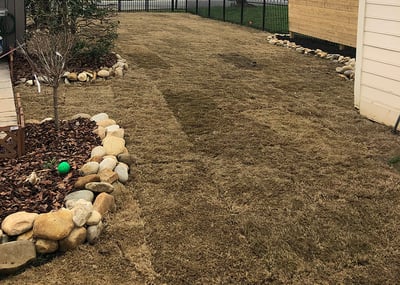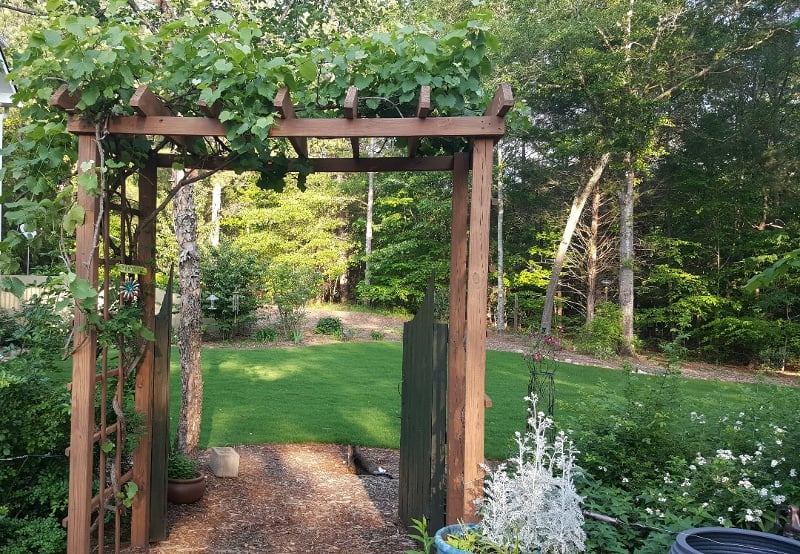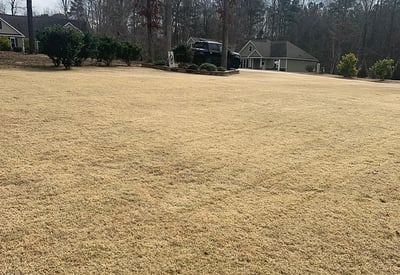

Happy "spring transition" month! April is the transition month when warm season lawns are coming out of dormancy and greening up in the South.
What "spring transition" means, besides happiness over a green lawn, is that your warm season lawn is starting to grow and you may need to mow your lawn soon, so be on the lookout for green spears of grass sprouting through your dormant lawn.
The typical April spring transition to a green lawn is already happening, especially in Zones 8a and warmer (such as on the coastal plain).
In colder zones, spring temperatures are a roller coaster ride. In Zones 7b and colder to 6b, your warm season lawn may still be dormant or is starting greening up (depending on the type of lawn).
No two Aprils are ever the same, so take heart that if your Bermuda, Centipede, or Zoysia lawn is only partially green - it will be okay and will turn completely green when temperatures are consistently warm, hopefully by the end of the month.
Also, keep in mind that not all areas will green up at the same time. For example, warmer sections on top of a hill or by a concrete driveway will green up before areas on the north side of a building or at the bottom of a slope.
If you're interested, you can look up your plant hardiness zone here.
Fertilizing Tips for Warm Season Lawns
- Prepare to fertilize your warm season lawn (Zoysia, Bermuda, Centipede) after it has fully greened up.
- Our Total Lawn Food 16-4-8 + Iron is what you want for Zoysia and Bermuda lawns. Order 16-4-8 for pick up or delivery or check out our Lawn Coach subscription.
Read the Best Times to Apply Fertilizer >> - Your TifBlair Centipede should be fertilized with very little fertilizer. We have our own special formulation just for it with lower nitrogen: Centipede Formulation 5-10-30 + Iron. Order 5-10-30 for pick up or delivery or check out our Lawn Coach subscription.
Read Fertilizer Tips for Your Centipede Lawn >>
Aerating Tips for Warm Season Lawns
- Continue to hold off aerating warm season lawns until they fully green up and soil temperatures are consistently above 70 degrees.
- Please bear in mind that aeration lessens the effectiveness of an April application of pre-emergent herbicide (see first point below). Therefore, you will get the best weed protection if you wait until mid-summer to aerate your lawn.
Weeding Tips for Warm Season Lawns
- Pre-emergent herbicide is our #1 tip for weed control. It's such a good tip that we filmed a video all about this rewarding lawn care practice. Watch it here.

- ❗Apply Your Second Spring Application of Pre-emergent: It's almost time for pre-emergent again! Apply this second application from mid April through late April.
- However, it's crucial to understand that this April pre-emergent application is the second half of a two part treatment - the first one was done in February. The February treatment prevents most summer weeds, including crabgrass. This second April application works best in tandem with the first, so please note that if you didn't spread pre-emergent in February, and are only spreading now in April, that you'll still see some summer weeds, such as crabgrass. Think of the April application like it's a booster shot.
- For Bermuda and Zoysia lawns that are greened up, we recommend 16-4-8 with Barricade pre-emergent. Order it online for pick up or delivery or check out our Lawn Coach subscription.
- For Centipede we recommend 0-0-7 with Barricade pre-emergent only if you skipped the February pre-emergent application for Centipede. Due to Centipede's sensitivity to herbicides, we recommend pre-emergent only twice a year, ideally in February and September. Order it online for pick up or delivery or check out our Lawn Coach subscription.
- 👍 Pre-emergent Rule of Thumb: Apply pre-emergent only on established warm season lawns. If your Bermuda lawn was planted within the last 6 months or your Zoysia/Centipede was planted in the last 12 months, then skip this pre-emergent application and resort to the methods below.
- Post-emergent herbicide in Established Warm Season lawns: Weather permitting, you can apply post-emergent liquid herbicides for weeds you can see now in established warm season lawns. These post-emergents work best above 65 degrees so apply it on the warmest spring days. Read the label and follow instructions.
- Pulling by Hand: If you don't have many weeds, it's quick and cost-effective to just yank them up.
- Mowing: Mow those weeds down before they go to seed. Most winter weeds are going to seed right now so get out there with your mower today! Mowing is an effective way to suppress weeds because it cuts off flower/seed heads and that stops weeds from making more weeds, thus breaking the life cycle. If you have bad winter weeds, mow on a weekly routine and don't let the weeds get ahead of you.
- Mulch suppresses weed seeds in flower beds. Spread your favorite mulch 2-4" thick and keep it 1-2" away from touching the trunks or stems of your plants. Rake/blow leaves off your lawn and into your beds and natural areas rather than bagging them.
Featured Weeds - Dead Nettle & Henbit
Dead nettle and henbit weeds are at max capacity in April. Dead nettle and henbit look a lot alike because they're in the same family. In our blog we explain how to quickly tell them apart.Learn about these edible lawn weeds and how to get rid of them in your lawn (maybe eat them?): April Weed of the Month: Dead Nettle & Henbit
Mowing Tips for Warm Season Lawns
Dust off your mower if you haven't already! I'm near Athens, GA, on the borderline of Zone 7b and 8a and I'm going to make a mowing pass over my lawn this weekend. My Zeon Zoysia already starting to grow and since mowing is the best thing I can do for my lawn (besides watering), I am eager to stay ahead of the growth.
Get your mower in shape to mow your lawn on a regular basis this growing season:
- Start by cleaning off plant debris from last year.
- Did you drain the gas last fall? If not, you'll need to address getting your mower started again - if it won't start, check your spark plugs and carburetor.
- If you have an electric mower, test the battery and make sure it wasn't drained by the polar blast before Christmas. You may need to buy a new battery.
- Inspect your mower blades. Do they need sharpening? (They probably do.) You can take off the blades and take them to be sharpened or you can buy new ones if they're that bad.
- Get fresh gas and oil, plus change the spark plug, oil, air filter, and fuel filter.
Mowing Height: There is a healthy range for each type of lawn. Do you know the best height for your lawn? Look them up at: Summer Mowing for Warm Season Grasses
Lay Warm Season Sod in April, Even During Spring Transition
If bare spots are driving you crazy or you have made renovations, you can stop all that mud by laying dormant or transitioning sod.
No problem! It's about to wake up, including the roots, so it will establish faster than in the winter.
We recommend you read our article on laying dormant sod for a few important tips.
Come back next month for May's Lawn Tips for Warm Season lawns!
If you have a Tall Fescue lawn (the best cool season lawn for the Southeast), here are our April tips for Tall Fescue lawns.
Got questions? Leave a comment below!
New here? Subscribe to our emails to get this information in your inbox every month.






